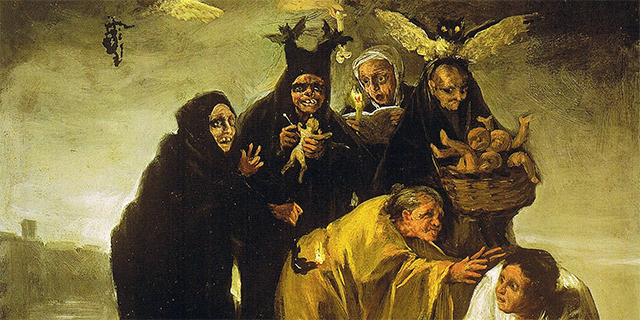
One of Francesco de Goya’s witch paintings
Why were women so vulnerable to being accused of witchcraft?
By 1712, when our new play Jane Wenham: Witch of Walkern is set, the most intense period of witch hunting was over, although still within living memory. During the height of the hunts somewhere between 100,000 and 200,000 people were tried and of those 50,000 to 100,000 executed. The idea of a witch had changed from someone who used magic for good or evil, to someone who had made a pact with the Devil to his bidding. It became not just about what you did but who you were, and to the authorities it became less important to prove a witch had committed evil magic in order to secure a conviction.
A huge proportion of those accused and killed were women. Here’s some background:
Women were the preservers of popular culture
It has been argued the “witchcraze” was part of a larger struggle by the elites to suppress popular culture, and to force those in rural areas to assimilate urban values. Women were the preservers and transmitters of popular culture, and so particularly suspect.
There were increasing numbers of unmarried women
During the sixteenth century, there were more unmarried women who were seen as out of the control of a man, and hence more suspect. This happened because people married at a later age, the number of people who never married also increased, female life expectancy rose, and male life expectancy decreased as a result of religious wars.
Women were less powerful
Women were seen as having less physical, economic, and political power than men, and therefore likelier to resort scolding, cursing and casting spells.
Women worked with with the young and the sick
Women women worked in areas of life in which witchcraft appeared to explain tragic events: they watched over animals which could die mysteriously; prepared food which could become spoiled inexplicably; nursed the sick of all ages who could die without warning; and cared for children who were even more likely to die unexpectedly.
Some women embraced their reputation for witchcraft
We might assume that women would do everything they could to avoid accusations of witchcraft, but a reputation for witchcraft could protect a woman and some embraced it. This might explain the number of women who confessed to being witches without the application or even threat of torture—after years of providing magical services, they were as convinced as their neighbours of their own powers.
Women accused women
Women number prominently amongst accusers and witnesses because the actions witches were initially charged with were generally part of women’s sphere. Household or neighbourhood antagonisms often led to accusations, particularly between those women who knew each other’s lives intimately, such as servants and mistresses or close neighbours.
This information is taken from a brilliant programme essay by Dr Roberta Anderson. You can read the essay in the programme-script for Jane Wenham: The Witch of Walkern
BOOK TICKETS TO SEE JANE WENHAM: THE WITCH OF WALKERN

 Search
Search
